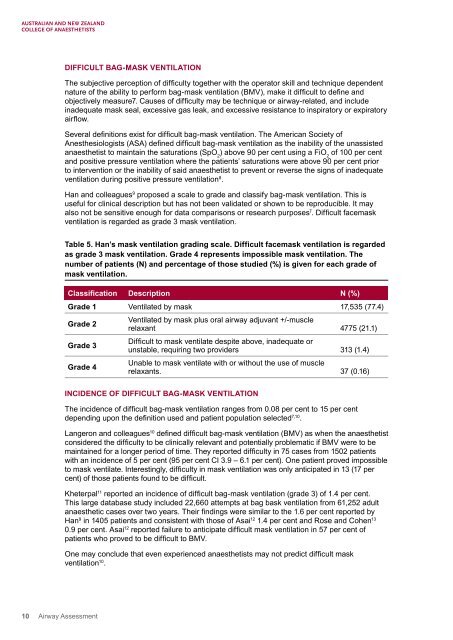Airway Assessment
2cKbSEQ
2cKbSEQ
Create successful ePaper yourself
Turn your PDF publications into a flip-book with our unique Google optimized e-Paper software.
DIFFICULT BAG-MASK VENTILATION<br />
The subjective perception of difficulty together with the operator skill and technique dependent<br />
nature of the ability to perform bag-mask ventilation (BMV), make it difficult to define and<br />
objectively measure7. Causes of difficulty may be technique or airway-related, and include<br />
inadequate mask seal, excessive gas leak, and excessive resistance to inspiratory or expiratory<br />
airflow.<br />
Several definitions exist for difficult bag-mask ventilation. The American Society of<br />
Anesthesiologists (ASA) defined difficult bag-mask ventilation as the inability of the unassisted<br />
anaesthetist to maintain the saturations (SpO 2<br />
) above 90 per cent using a FiO 2<br />
of 100 per cent<br />
and positive pressure ventilation where the patients’ saturations were above 90 per cent prior<br />
to intervention or the inability of said anaesthetist to prevent or reverse the signs of inadequate<br />
ventilation during positive pressure ventilation 8 .<br />
Han and colleagues 9 proposed a scale to grade and classify bag-mask ventilation. This is<br />
useful for clinical description but has not been validated or shown to be reproducible. It may<br />
also not be sensitive enough for data comparisons or research purposes 7 . Difficult facemask<br />
ventilation is regarded as grade 3 mask ventilation.<br />
Table 5. Han’s mask ventilation grading scale. Difficult facemask ventilation is regarded<br />
as grade 3 mask ventilation. Grade 4 represents impossible mask ventilation. The<br />
number of patients (N) and percentage of those studied (%) is given for each grade of<br />
mask ventilation.<br />
Classification Description N (%)<br />
Grade 1 Ventilated by mask 17,535 (77.4)<br />
Grade 2<br />
Grade 3<br />
Grade 4<br />
Ventilated by mask plus oral airway adjuvant +/-muscle<br />
relaxant 4775 (21.1)<br />
Difficult to mask ventilate despite above, inadequate or<br />
unstable, requiring two providers 313 (1.4)<br />
Unable to mask ventilate with or without the use of muscle<br />
relaxants. 37 (0.16)<br />
INCIDENCE OF DIFFICULT BAG-MASK VENTILATION<br />
The incidence of difficult bag-mask ventilation ranges from 0.08 per cent to 15 per cent<br />
depending upon the definition used and patient population selected 7,10 .<br />
Langeron and colleagues 10 defined difficult bag-mask ventilation (BMV) as when the anaesthetist<br />
considered the difficulty to be clinically relevant and potentially problematic if BMV were to be<br />
maintained for a longer period of time. They reported difficulty in 75 cases from 1502 patients<br />
with an incidence of 5 per cent (95 per cent CI 3.9 – 6.1 per cent). One patient proved impossible<br />
to mask ventilate. Interestingly, difficulty in mask ventilation was only anticipated in 13 (17 per<br />
cent) of those patients found to be difficult.<br />
Kheterpal 11 reported an incidence of difficult bag-mask ventilation (grade 3) of 1.4 per cent.<br />
This large database study included 22,660 attempts at bag bask ventilation from 61,252 adult<br />
anaesthetic cases over two years. Their findings were similar to the 1.6 per cent reported by<br />
Han 9 in 1405 patients and consistent with those of Asai 12 1.4 per cent and Rose and Cohen 13<br />
0.9 per cent. Asai 12 reported failure to anticipate difficult mask ventilation in 57 per cent of<br />
patients who proved to be difficult to BMV.<br />
One may conclude that even experienced anaesthetists may not predict difficult mask<br />
ventilation 10 .<br />
10 <strong>Airway</strong> <strong>Assessment</strong>


